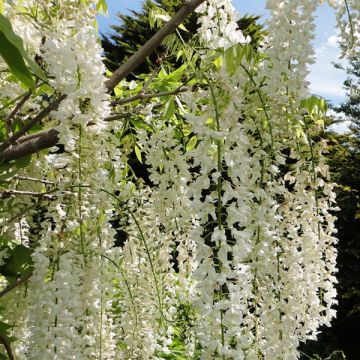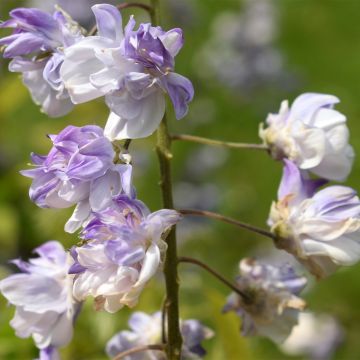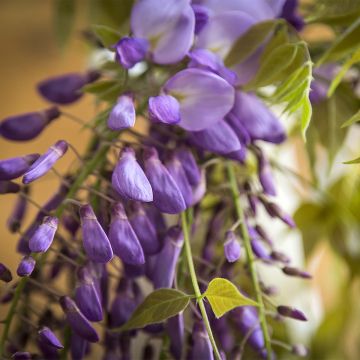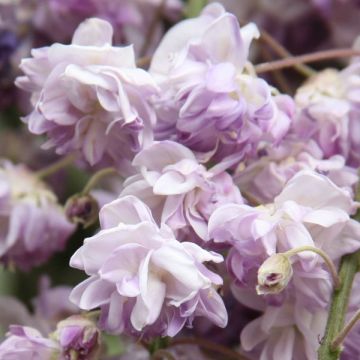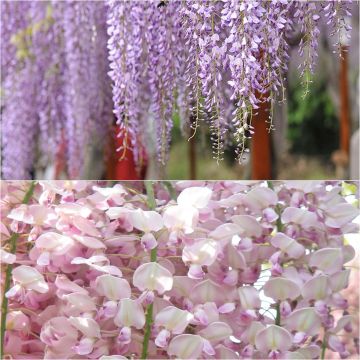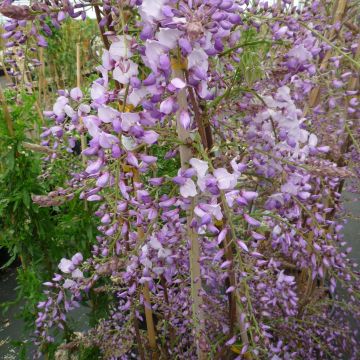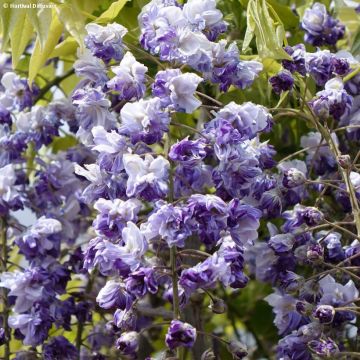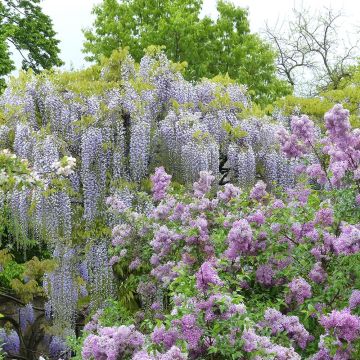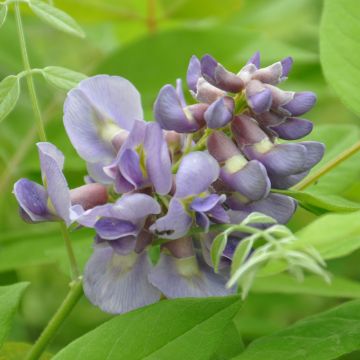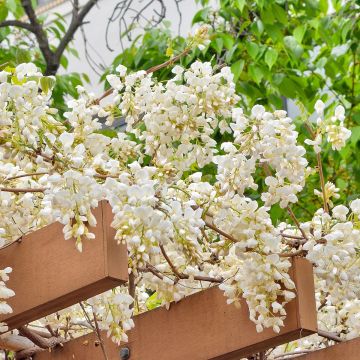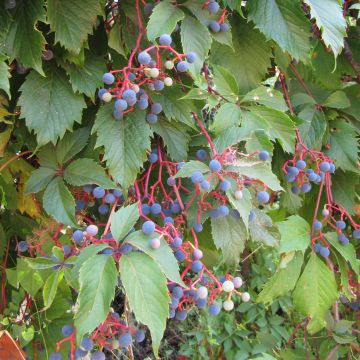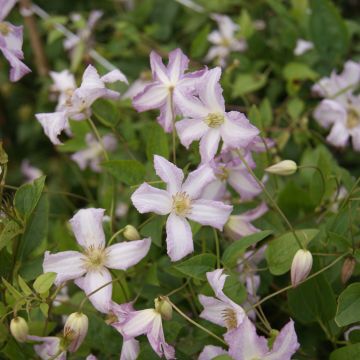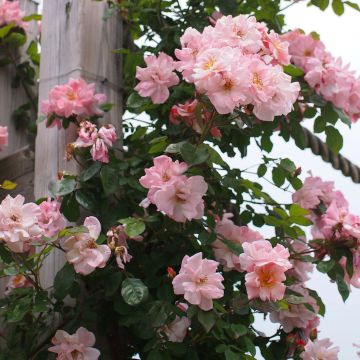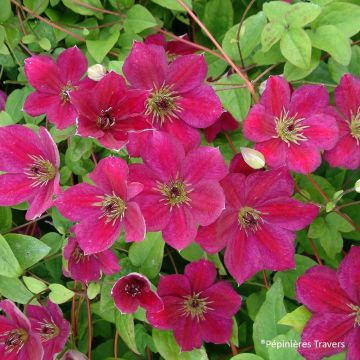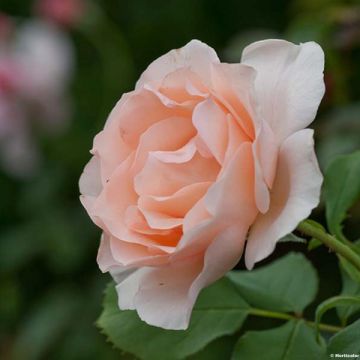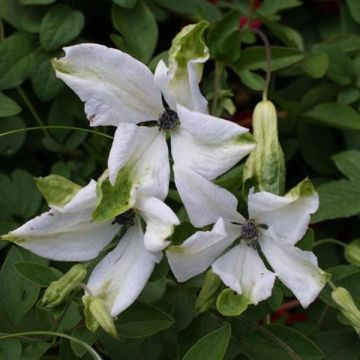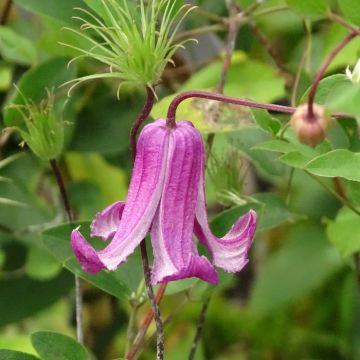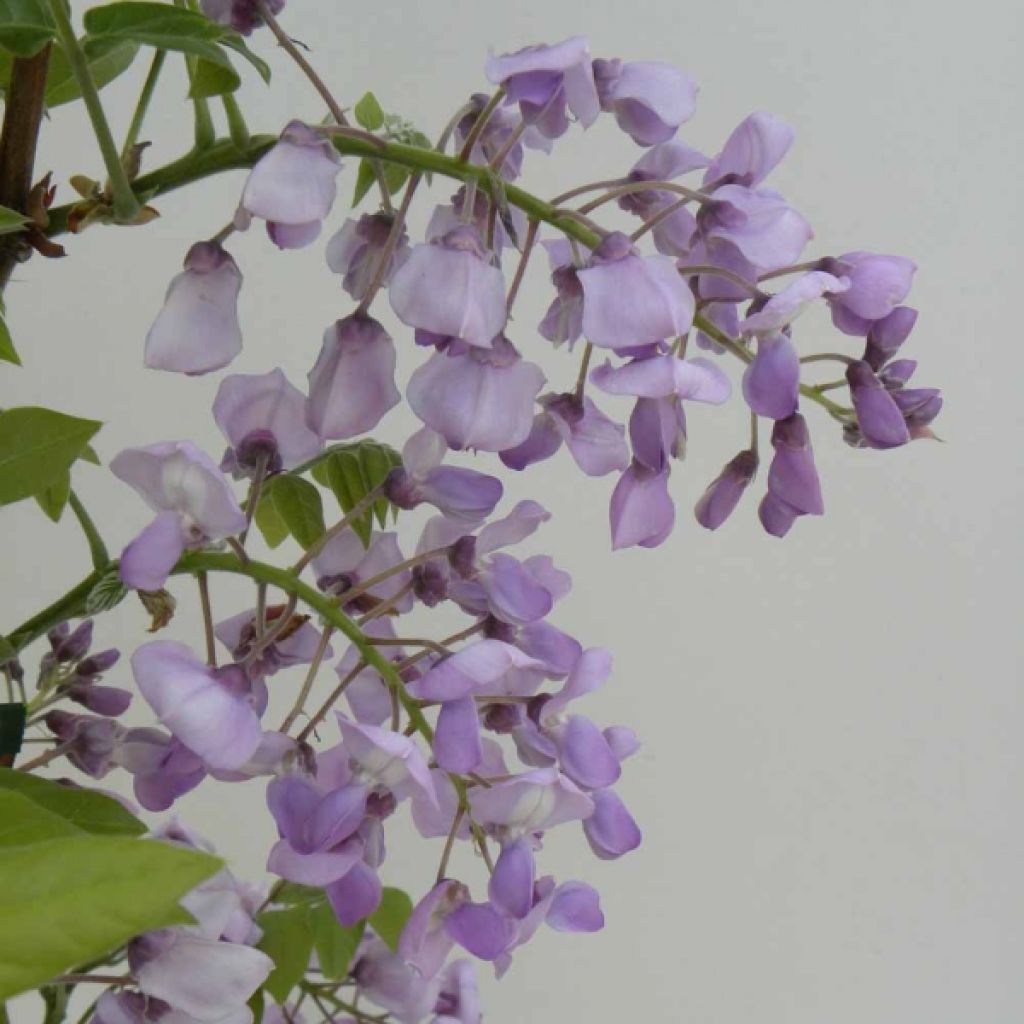

Wisteria venusta Okayama
Wisteria venusta Okayama
Wisteria venusta Okayama
Silky Wisteria, Japanese Wisteria
This item cannot be shipped to the selected country
Delivery charge from €5.90
More information
Schedule delivery date,
and select date in basket
This plant carries a 6 months recovery warranty
More information
We guarantee the quality of our plants for a full growing cycle, and will replace at our expense any plant that fails to recover under normal climatic and planting conditions.
From €5.90 for pickup delivery and €6.90 for home delivery
Express home delivery from €8.90.
Does this plant fit my garden?
Set up your Plantfit profile →
Description
Wisteria venusta 'Okayama' is a variety of Japanese Wisteria with slow growth, infinitely graceful, which will seduce with the abundance and wonderful fragrance of its spring flowers. Its flower clusters are rather short but well supplied with dark purple buds that open into large pea-like flowers of a lovely purple-mauve colour. Hardy and as accommodating as its Chinese or American cousins, it is the least vigorous of the Wisterias, ideal for small spaces. It also has another major advantage: the gardener will not have to wait for many years before admiring its flowers.
The Okayama Wisteria is a horticultural creation selected in Hokayama, Japan. Its wild ancestor Wisteria venusta (=brachybotrys) is a Japanese botanical species of modest stature also known as the Silky Wisteria. It is a deciduous climbing plant producing long twining stems that wrap around their support in a counterclockwise direction. Its root system is deep and trailing, composed of fibrous roots that live in association with bacteria and mycorrhizae. This indicates a good adaptation to poor and fairly dry soils.
The Okayama variety, with relatively slow growth, reaches an average height of 4m (13ft). It can be pruned as a 2m (7ft) bush in all directions. The plant blooms in April-May, while already carrying young bronze-coloured leaves. The inflorescences are produced profusely. They are pendulous conical clusters, compact, measuring about 20cm (8in) long, still tightly closed when the buds take on colour. The mauve flowers are large compared to those of other wisterias. Their complex fragrance reveals notes of jasmine, orange blossom, caramel, and honeysuckle, somewhat reminiscent of Spanish broom with a hint of camphor and cloves. The fruits, shaped like velvety beans, measure from 10 to 15cm (4 to 6in) long. The leaves, 20 to 35cm (8 to 14in) long, are divided into 9 to 13 leaflets of a medium green colour, ovate, each measuring 4 to 8cm (2 to 3in) long. They turn a very warm yellow quite late in autumn before falling. Branches and leaves are slightly pubescent.
Wisteria venusta 'Okayama' is perfect for covering a wall, a railing, a pergola, an arbour, or a porch in romantic gardens, including small ones. While wisteria branches can usually entwine with the sturdiest trellis, this variety is much more "respectful" of the supports that welcome it. Plant it also in a large container on the balcony or terrace. It will pair well with a Mayleen clematis montana, a Purpurea Plena Elegans clematis, some perennial peas...
Report an error about the product description
Wisteria venusta Okayama in pictures
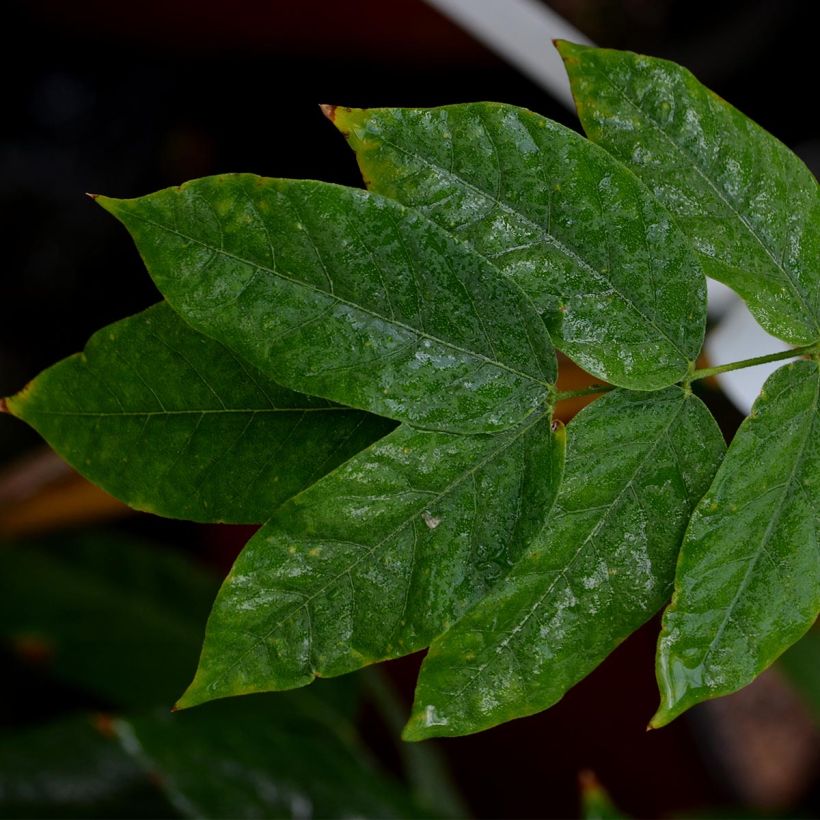

Plant habit
Flowering
Foliage
Botanical data
Wisteria
venusta
Okayama
Fabaceae
Silky Wisteria, Japanese Wisteria
Cultivar or hybrid
Other Wisterias
Planting and care
Wisteria venusta Okayama should be planted in autumn or early spring in deep and well-drained soil in a sunny or semi-shaded position. It doesn't like too much limestone, which causes its leaves to turn yellow, so prefers slightly acidic to neutral soil. Add compost and water well after planting. Once well established, this climbing plant can do without watering in summer in most areas. In February, when the flower buds are formed, prune back (to 2 buds) the branches that are bare, to improve airflow. Do not keep more than 4 flower buds (rounded) on the same stem. To train a wisteria to climb a tree does not require any pruning.
Planting period
Intended location
Care
-
, onOrder confirmed
Reply from on Promesse de fleurs
Foolproof climbers
Haven't found what you were looking for?
Hardiness is the lowest winter temperature a plant can endure without suffering serious damage or even dying. However, hardiness is affected by location (a sheltered area, such as a patio), protection (winter cover) and soil type (hardiness is improved by well-drained soil).

Photo Sharing Terms & Conditions
In order to encourage gardeners to interact and share their experiences, Promesse de fleurs offers various media enabling content to be uploaded onto its Site - in particular via the ‘Photo sharing’ module.
The User agrees to refrain from:
- Posting any content that is illegal, prejudicial, insulting, racist, inciteful to hatred, revisionist, contrary to public decency, that infringes on privacy or on the privacy rights of third parties, in particular the publicity rights of persons and goods, intellectual property rights, or the right to privacy.
- Submitting content on behalf of a third party;
- Impersonate the identity of a third party and/or publish any personal information about a third party;
In general, the User undertakes to refrain from any unethical behaviour.
All Content (in particular text, comments, files, images, photos, videos, creative works, etc.), which may be subject to property or intellectual property rights, image or other private rights, shall remain the property of the User, subject to the limited rights granted by the terms of the licence granted by Promesse de fleurs as stated below. Users are at liberty to publish or not to publish such Content on the Site, notably via the ‘Photo Sharing’ facility, and accept that this Content shall be made public and freely accessible, notably on the Internet.
Users further acknowledge, undertake to have ,and guarantee that they hold all necessary rights and permissions to publish such material on the Site, in particular with regard to the legislation in force pertaining to any privacy, property, intellectual property, image, or contractual rights, or rights of any other nature. By publishing such Content on the Site, Users acknowledge accepting full liability as publishers of the Content within the meaning of the law, and grant Promesse de fleurs, free of charge, an inclusive, worldwide licence for the said Content for the entire duration of its publication, including all reproduction, representation, up/downloading, displaying, performing, transmission, and storage rights.
Users also grant permission for their name to be linked to the Content and accept that this link may not always be made available.
By engaging in posting material, Users consent to their Content becoming automatically accessible on the Internet, in particular on other sites and/or blogs and/or web pages of the Promesse de fleurs site, including in particular social pages and the Promesse de fleurs catalogue.
Users may secure the removal of entrusted content free of charge by issuing a simple request via our contact form.
The flowering period indicated on our website applies to countries and regions located in USDA zone 8 (France, the United Kingdom, Ireland, the Netherlands, etc.)
It will vary according to where you live:
- In zones 9 to 10 (Italy, Spain, Greece, etc.), flowering will occur about 2 to 4 weeks earlier.
- In zones 6 to 7 (Germany, Poland, Slovenia, and lower mountainous regions), flowering will be delayed by 2 to 3 weeks.
- In zone 5 (Central Europe, Scandinavia), blooming will be delayed by 3 to 5 weeks.
In temperate climates, pruning of spring-flowering shrubs (forsythia, spireas, etc.) should be done just after flowering.
Pruning of summer-flowering shrubs (Indian Lilac, Perovskia, etc.) can be done in winter or spring.
In cold regions as well as with frost-sensitive plants, avoid pruning too early when severe frosts may still occur.
The planting period indicated on our website applies to countries and regions located in USDA zone 8 (France, United Kingdom, Ireland, Netherlands).
It will vary according to where you live:
- In Mediterranean zones (Marseille, Madrid, Milan, etc.), autumn and winter are the best planting periods.
- In continental zones (Strasbourg, Munich, Vienna, etc.), delay planting by 2 to 3 weeks in spring and bring it forward by 2 to 4 weeks in autumn.
- In mountainous regions (the Alps, Pyrenees, Carpathians, etc.), it is best to plant in late spring (May-June) or late summer (August-September).
The harvesting period indicated on our website applies to countries and regions in USDA zone 8 (France, England, Ireland, the Netherlands).
In colder areas (Scandinavia, Poland, Austria...) fruit and vegetable harvests are likely to be delayed by 3-4 weeks.
In warmer areas (Italy, Spain, Greece, etc.), harvesting will probably take place earlier, depending on weather conditions.
The sowing periods indicated on our website apply to countries and regions within USDA Zone 8 (France, UK, Ireland, Netherlands).
In colder areas (Scandinavia, Poland, Austria...), delay any outdoor sowing by 3-4 weeks, or sow under glass.
In warmer climes (Italy, Spain, Greece, etc.), bring outdoor sowing forward by a few weeks.

































